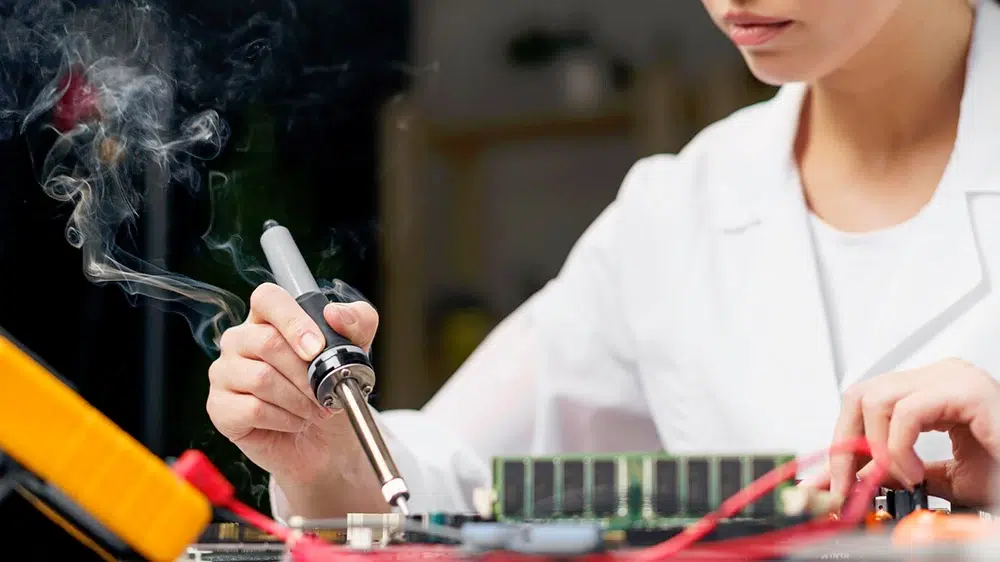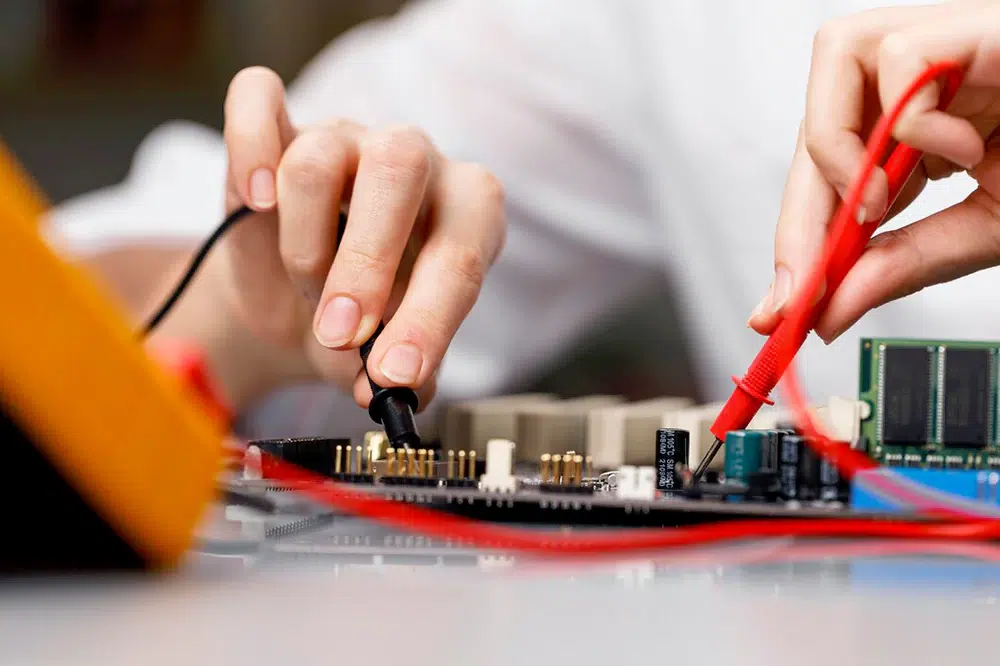When it comes to assembling and maintaining circuit boards, selecting the right adhesive is crucial for ensuring durability, performance, and reliability. With various types of glues available, each offering unique properties, choosing the best glue for your specific PCB (Printed Circuit Board) application can be challenging. This article explores different types of glues used in PCB assembly and provides insights into determining which one is best suited for your needs.
Red Glue
Red Glue is a type of polyolefin compound that cures upon heating. When the temperature reaches its solidification point of 150°C, the red Glue starts to change from a paste to a solid. This characteristic allows it to be used for fixing surface-mount components through dispensing or printing methods. For circuit board components, red Glue can be cured using an oven or reflow soldering.
For components on a circuit board, especially on double-sided boards, using red Glue during wave soldering helps prevent small surface-mount components on the backside from falling into the solder bath. Key features of red Glue include:
1. It provides stable adhesion strength for various chip components.
2. It has suitable viscosity and flow characteristics for screen printing, ensuring consistent application without missing areas or uneven application.
3. It exhibits excellent stability in storage.
4. It has high adhesion strength, which helps prevent component displacement during high-speed mounting.
Primary Function: The main function of red Glue is to secure surface-mount components on the circuit board, providing Glue properties or reinforcement when used together with solder paste.
Yellow Glue
The yellow Glue used for circuit boards is a water-based Glue with a distinctive odor. It is a soft, self-Glue gel with excellent insulation, moisture resistance, shock absorption, and thermal conductivity, which ensures the safe operation of electronic components under harsh conditions.
It cures relatively easily, with the curing speed dependent on environmental temperature, humidity, and airflow: higher temperatures, lower humidity, and greater airflow speed up the curing process, while the opposite conditions slow it down. Components coated with the Glue will gradually form a skin if left exposed to air, so the application should be completed before this skin forms.
Primary Function: Yellow Glue is used to secure electronic products such as inductors, coils, transformers, electrolytic capacitors, and receivers. It provides protection and sealing for electronic components and can be used for potting electrical components, encapsulating high-voltage parts, and coating circuit boards for moisture protection.
Thermal Conductive Silicone
Thermal conductive silicone, also known as thermal grease or thermal paste, is a high thermal conductivity insulating silicone material. Unlike thermal silicone grease, which can remain in a paste-like state almost indefinitely, thermal conductive silicone maintains its paste-like consistency across a wide temperature range of -50°C to +250°C. It combines excellent electrical insulation with superior thermal conductivity, low oil bleed (nearly zero), and resistance to extreme temperatures, water, ozone, and weathering. It is non-toxic, odorless, non-corrosive, and meets ROHS standards and other environmental requirements, with stable chemical and physical properties.
Primary Function: It is used to fill gaps between heat sources and heat dissipation devices, increasing their contact area to enhance thermal conductivity and effectively dissipate heat generated during the operation of electronic components.
It is widely applied between heating elements (such as power transistors, thyristors, and electric heating stacks) and heat dissipation facilities (such as heat sinks, heat spreaders, and housings) in various electronic products and electrical devices to improve heat dissipation efficiency.
Silicone Adhesive
Silicone adhesive is a paste-like material that cures into a tough, rubber-like solid when exposed to moisture in the air. Commonly used for bonding and sealing glass, it is often referred to as “glass glue.” The adhesive should be stored in a sealed container, and any mixed adhesive should be used up in one go to avoid waste.
Primary Function: It is widely used for potting, insulating, and flame-retardant applications in electronic modules, sensors, and electronic components, as well as for bonding and insulating between electronic components.
Hot Melt Adhesive
Hot melt adhesive sticks are primarily made from ethylene-vinyl acetate (EVA) polymer, combined with modified rosin or petroleum resins and other components. This solid adhesive is a plastic, non-toxic, odorless, environmentally friendly adhesive. Its physical state changes with temperature within a specific range, while its chemical properties remain constant. It is completely free of water or solvents, and features quick bonding, high strength, durability, non-toxicity, good thermal stability, and toughness of the adhesive film.
Hot melt adhesive should be heated to the appropriate application temperature and applied with a gun or brush. Bonding and setting must be completed within the adhesive’s open time, and the bonded items should be clamped until cooled to room temperature. Hot melt adhesive is solid at the application temperature, melts into a liquid when heated, and bonds within seconds after cooling to room temperature, effectively securing electronic components and wiring.
Primary Function: Hot melt adhesive is suitable for fixing electronic components, bonding electrical connections, and can also be used for bonding other electronic materials. It is also applicable for arts and crafts, packaging boxes, decorations, handicrafts, wood, and textile samples.
Conductive Adhesive
Overview: Conductive adhesive contains materials like silver or copper to provide both adhesive bonding and electrical conductivity. It is used in applications where electrical connections are needed.
Advantages:
Electrical Conductivity: Allows current to pass through, essential for certain electronic applications.
Bonding and Conductivity: Provides both mechanical adhesion and electrical connection.
Best For: Conductive adhesive is best suited for bonding components where electrical conductivity is required, such as in conductive traces or connections on PCBs.
Choosing the Best Glue for Your PCB
When selecting the best glue for your circuit board, consider the following factors:
Application Requirements: Determine whether you need a glue for thermal management, flexible bonding, general-purpose use, or electrical conductivity.
Environmental Conditions: Assess the operating environment, including temperature extremes, moisture, and exposure to chemicals.
Bonding Strength: Choose a glue that provides the necessary strength and durability for your specific application.
Each type of glue has its strengths and is designed for specific uses in PCB assembly. By understanding the unique properties of each glue and evaluating your project’s requirements, you can make an informed decision and ensure optimal performance and reliability for your circuit boards.
Common types of glue used for PCBs include:
Red Adhesive (Polyolefin-Based Adhesive): For securing surface-mount components during soldering.
Thermal Conductive Silicone: For improving heat transfer between components and heat sinks.
Silicone Adhesive: For potting, sealing, and insulating components.
Hot Melt Adhesive: For general bonding and quick fixes.
Epoxy Adhesive: For strong, permanent bonds and repairs.
Conductive Adhesive: For applications requiring electrical conductivity.
Consider the following factors:
Application Requirements: Determine if you need glue for thermal management, bonding, or electrical conductivity.
Environmental Conditions: Assess the temperature range, moisture, and exposure to chemicals.
Bonding Strength: Choose an adhesive that provides the required strength for your application.
Curing Process: Consider the curing time and method (e.g., heat, air) and how it fits with your assembly process.
Thermal conductive silicone is a paste-like adhesive that enhances heat transfer between components and heat sinks. It is ideal for applications where managing heat is crucial, such as high-power or high-temperature electronics.














